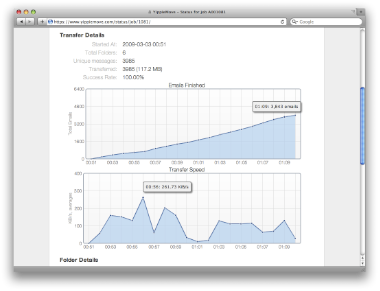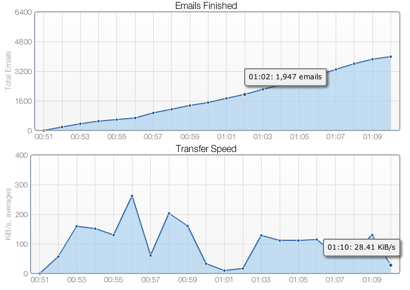New Playing With Wire writer Lore Dionne Candelaria takes a look at the history of email and what led to its enormous impact on our modern lives.
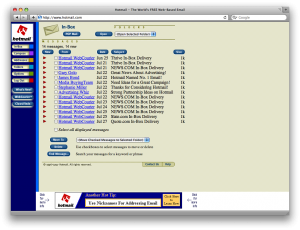
Old meets new: early version of Hotmail displayed in Safari 3
Ever since the dawn of human existence, it has been an instinct of man to try to find ways to reach out and to be able to be heard. Speech and language proved to be the most important tools of the ancient human. Humankind has used these tools to survive and to exchange thoughts; which later evolved into other forms that made use of written symbols, drawings, runes and many other variations. The natural next step in this desire to innovate was the attempts to conquer distance — man wanted to still be in touch besides being apart. Carrier pigeons and smoke signals paved the way for a line of development aiming for an infinite means of communication. Thus came the discovery and birth of technologies like the telegraph, telephone, and ultimately, the e-mail system.
Before we can talk about the creation of electronic mail, we should first understand the beginnings of the internet itself. Many people have probably heard that the Internet began in some military computers in the famous Pentagon, that it was called Arpanet, and that the year was 1969. The theory goes on to suggest that the network was designed to survive a nuclear attack. True enough, the Internet was designed in part to provide a communications network that would work even if some of the sites were destroyed by nuclear attack. In 1969, the US Department of Defense wanted a communication system that could not be destroyed in the event of an emergency. They linked computers over telephone lines so that if one computer failed to work, the others could still communicate with each other. This system was called then as ARPANET.
ARPANET (Advanced Research Projects Agency Networks) was the network that became the basis for the development of the INTERNET. It was developed under the direction of the U.S. Advanced Research Projects Agency (ARPA). In 1969, the idea became a modest reality with the interconnection of four university computers. The initial purpose was to communicate with and share computer resources among mainly scientific users at the connected institutions. ARPANET took advantage of the new idea of sending information in small units called packets that could be routed on different paths and reconstructed at their destination. The main concept in packet switching was the idea of making use of circuits that are switched like in the old type of typical telephone circuit, where a dedicated circuit is tied up for the duration of the call and communication is only possible with the single party on the other end of the circuit.
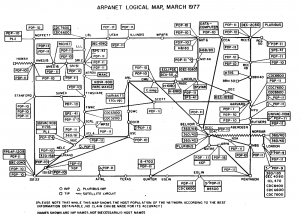
ARPANET logic map, March 1977 (From Computer Science Museum)
The starting point for host-to-host communication on the ARPANET was the 1822 protocol which defined the way that a host sent messages to an ARPANET IMP. The message format was designed to work unambiguously with a broad range of computer architectures. Essentially, an 1822—message consisted of a message type, a numeric host address, and a data field. To send a data message to another host, the sending host would format a data message containing the destination host’s address and the data to be sent, and transmit the message through the 1822 hardware interface. The IMP would see that the message was delivered to its destination, either by delivering it to a locally-connected host or by delivering it to another IMP. When the message was ultimately delivered to the destination host, the IMP would send an acknowledgment message (called Ready for Next Message or RFNM) to the sending host.
So, how exactly did email evolve from the classic ARPANET? The answer comes from the name of Raymond Tomlinson. Tomlinson, born in 1941, is a programmer who implemented an email system in 1971 on the ARPANet. Email had been previously sent on other networks. Before internetworking began, email could only be used to send messages to various users of the same computer. Once computers began talking to each other over networks, however, the problem became a little more complex—they needed to be able to put a message in an envelope and address it. To do this, they needed a means to indicate which mails go to whom in a way that the electronic posts understood. This is the same as the conventional postal system: they need a way to indicate an address for a particular mail. The AUDOTIN was the first system able to send mail between users on different hosts connected to the Arpanet. To achieve this, Tomlinson used the @ sign to separate the user from their machine, the “commercial at” symbol to combine the user and host names, providing the naturally meaningful notation “user@host”—that is the standard for email addressing today. This has been used in email addresses ever since. These early programs had simple functionality and were command line-driven, but established the basic transactional model that still defines the technology: email gets sent to someone’s mailbox.
The first important email standard was called SMTP, or simple message transfer protocol. SMTP was very simple and is still in use – however, as we will hear later in this series, SMTP was a fairly naïve protocol, and made no attempt to find out whether the person claiming to send a message was the person they purported to be. Forgery was (and still is) very easy in email addresses. These basic flaws in the protocol were later exploited by viruses and worms, and by security frauds and spammers forging identities. But as it developed, email started to take on some pretty neat features. One of the first good commercial systems was Eudora, developed by Steve Dorner in 1988. When Internet standards for email began to mature the POP (or Post Office Protocol) servers began to appear as a standard; before that, each server was a little different. POP was an important standard which allowed users to develop mail systems. These were the days of per-minute charges for email of individual dialup users. For most people on the Internet in those days, email and email discussion groups were its main uses. There were many hundreds of these on a wide variety of topics, and as a body of newsgroups, they became known as USENET.

Raymond Tomlinson
With the World Wide Web, email started to be made available with friendly web interfaces by providers such as Yahoo and Hotmail. Usually this was without charge. Now that email was affordable, everyone wanted at least one email address, and the medium was adopted by not just millions, but hundreds of millions of people. This only proves how emailing has reached new horizons in helping people to connect with the virtual world.
Though it is undeniable that emailing has gone a long way since it was first conceptualized, conceived and born, it now faces more problems than ever. While one cannot question the importance of email and instant messaging nowadays, one question remains: what is in store for electronic mailing in the future? In this age when everyone is aware of the emergence of so many communication options, does email still makes sense? What’s worse, e-mail has become a tool for criminal hackers ready to show off their technical skills. Recently, organized crime has become more of a force in the spam arena. They developed a series of get-rich-quick schemes and have also leveraged spam as an entry point into collecting and then misusing individuals’ personal financial information. As a result, it is estimated that spam represents 80% to more than 90% of all e-mail messages. Consequently, some businesspeople are flocking to these new communications options to rid themselves of the tedious task of constantly hitting the delete button. Can one still trust the reliability of emailing in connecting and communicating with other people?
The answer lies on the platform that emailing has founded. The flaw that makes email so easy to abuse for spam and other nefarious activities is also it’s strength: it’s easy to get an e-mail address and nearly everyone has one. E-mail will continue to be a popular communication option precisely because it is so popular. Emailing continues to be a communications option that generates billions of messages each year.
Yes, new communication channels have emerged, they appeal to different sort of users, and they will be in use at times instead of e-mail. However, e-mail still has the broadest range of supporters and will continue to be the primary communications media for most businesspersons for the foreseeable future; especially now that there is a boom in the online business industry. Email has proven to be an efficient marketing and advertising medium. The increase in electronic commerce or e-commerce has once again pressured the mail developers to improve and better the functionalities of email systems.
For sure things will change and just like all else, e-mail will surely evolve, but its use as a communication medium is still unparalleled. It was after all created on top of technology built to survive.
Author: Lore Dionne Candelaria Tags: Email,
history,
internet





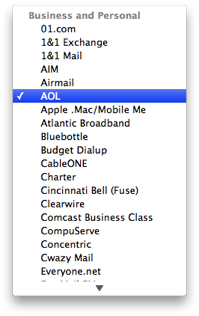 The idea of YippieMove is to unlock email and let the user make the switch to another email. When
The idea of YippieMove is to unlock email and let the user make the switch to another email. When 